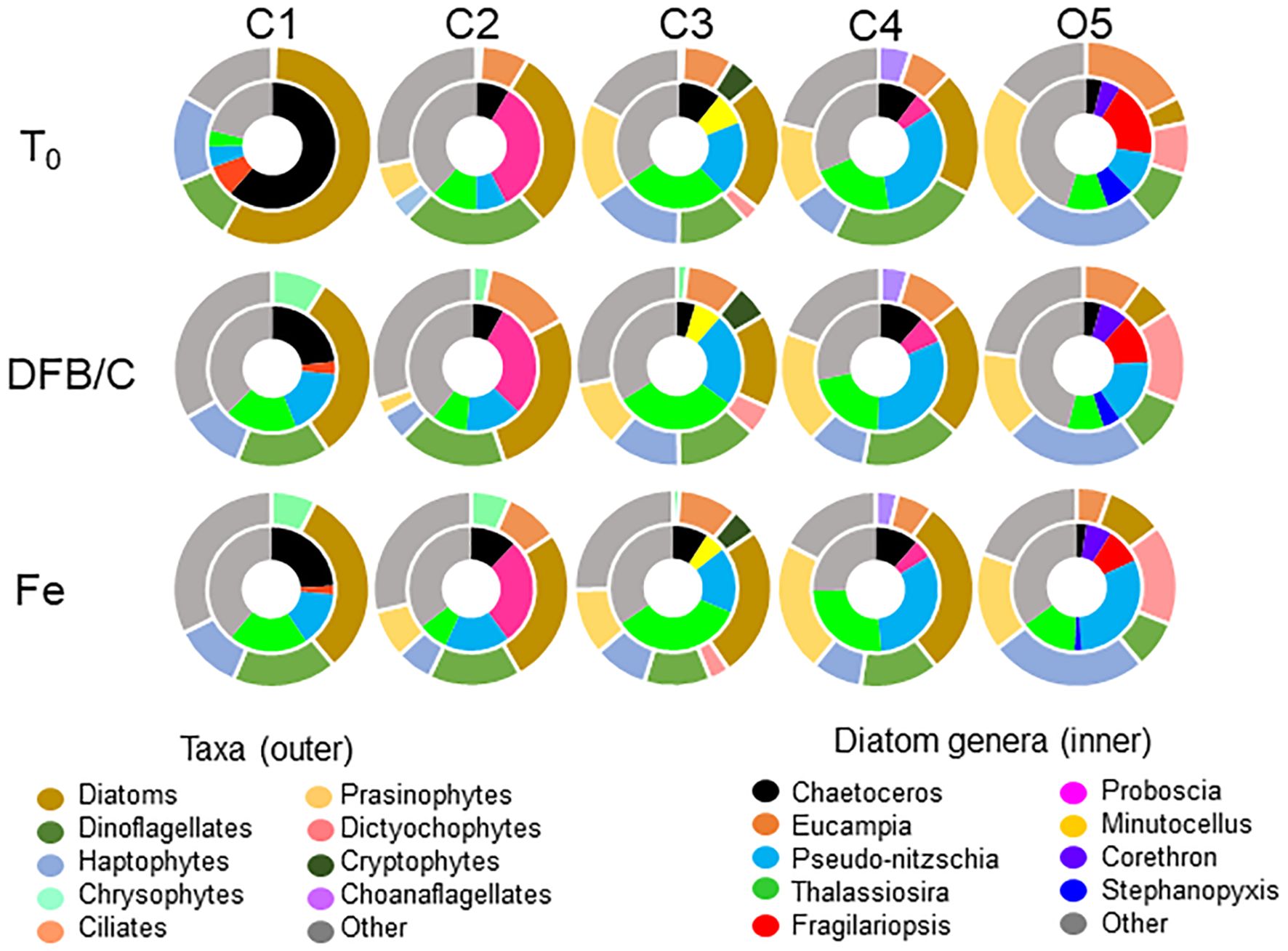- 1Department of Marine Sciences, University of North Carolina at Chapel Hill, Chapel Hill, NC, United States
- 2The Marine Science Institute and the Department of Ecology Evolution and Marine Biology, University of California, Santa Barbara, Santa Barbara, CA, United States
- 3Bigelow Laboratory for Ocean Sciences, East Boothbay, ME, United States
- 4Department of Earth, Ocean, and Atmospheric Sciences, University of British Columbia, Vancouver, BC, Canada
- 5Department of Marine and Coastal Sciences, Rutgers, the State University of New Jersey, New Brunswick, NJ, United States
- 6Department of Ocean Sciences, University of California, Santa Cruz, Santa Cruz, CA, United States
- 7Chemistry Department, Humboldt State University, Arcata, CA, United States
- 8Department of Oceanography and Coastal Sciences, College of the Coast and Environment, Louisiana State University, Baton Rouge, LA, United States
A Corrigendum on
Diatom transcriptional and physiological responses to changes in iron bioavailability across ocean provinces
By Cohen NR, Ellis KA, Lampe RH, McNair H, Twining BS, Maldonado MT, et al. (2017). Front. Mar. Sci. 4:360. doi: 10.3389/fmars.2017.00360
In the published article, there was an error in Figure 3 as published. The initial (T0) phytoplankton community composition at site C2 was incorrectly displayed, with prasinophytes erroneously appearing as relatively abundant taxa. The corrected Figure 3 appears below.

Figure 3. The average transcript proportions of phytoplankton taxa (outer charts) and diatom genera (inner charts) from initial seawater (T0) and during the first time point (T1; see Supplementary Table 1) within the Fe addition (Fe) and DFB addition (DFB) treatments at each site. Note that for site O5, the T2 control (Ctl) treatment is provided as the Fe-limited comparison.
A text correction has been made to Results, Community Composition across Sites, paragraph number 1. This sentence previously stated:
“In contrast, CUZ site C2 initially yielded a phytoplankton community transcript pool dominated equally by diatoms (30%) and prasinophytes (28%), with diatoms remaining a dominant taxa following incubation (26–28%) and prasinophyte transcripts substantially decreasing from 28 to 3–8% in both Fe and DFB incubations.”
The sentence has been removed.
The authors apologize for this error and state that this does not change the scientific conclusions of the article in any way. The original article has been updated.
Publisher’s note
All claims expressed in this article are solely those of the authors and do not necessarily represent those of their affiliated organizations, or those of the publisher, the editors and the reviewers. Any product that may be evaluated in this article, or claim that may be made by its manufacturer, is not guaranteed or endorsed by the publisher.
Keywords: diatoms, Thalassiosira, Pseudo-nitzschia, iron, metatranscriptomics, California Upwelling Zone, Northeast Pacific Ocean
Citation: Cohen NR, Ellis KA, Lampe RH, McNair H, Twining BS, Maldonado MT, Brzezinski MA, Kuzminov FI, Thamatrakoln K, Till CP, Bruland KW, Sunda WG, Bargu S and Marchetti A (2025) Corrigendum: Diatom transcriptional and physiological responses to changes in iron bioavailability across ocean provinces. Front. Mar. Sci. 12:1574405. doi: 10.3389/fmars.2025.1574405
Received: 10 February 2025; Accepted: 18 March 2025;
Published: 01 April 2025.
Edited and Reviewed by:
Kristian Spilling, Finnish Environment Institute (SYKE), FinlandCopyright © 2025 Cohen, Ellis, Lampe, McNair, Twining, Maldonado, Brzezinski, Kuzminov, Thamatrakoln, Till, Bruland, Sunda, Bargu and Marchetti. This is an open-access article distributed under the terms of the Creative Commons Attribution License (CC BY). The use, distribution or reproduction in other forums is permitted, provided the original author(s) and the copyright owner(s) are credited and that the original publication in this journal is cited, in accordance with accepted academic practice. No use, distribution or reproduction is permitted which does not comply with these terms.
*Correspondence: Adrian Marchetti, YW1hcmNoZXRAZW1haWwudW5jLmVkdQ==
 Natalie R. Cohen
Natalie R. Cohen Kelsey A. Ellis1
Kelsey A. Ellis1 Robert H. Lampe
Robert H. Lampe Heather McNair
Heather McNair Benjamin S. Twining
Benjamin S. Twining Maria T. Maldonado
Maria T. Maldonado Fedor I. Kuzminov
Fedor I. Kuzminov Kimberlee Thamatrakoln
Kimberlee Thamatrakoln Claire P. Till
Claire P. Till Kenneth W. Bruland
Kenneth W. Bruland William G. Sunda
William G. Sunda Sibel Bargu
Sibel Bargu Adrian Marchetti
Adrian Marchetti